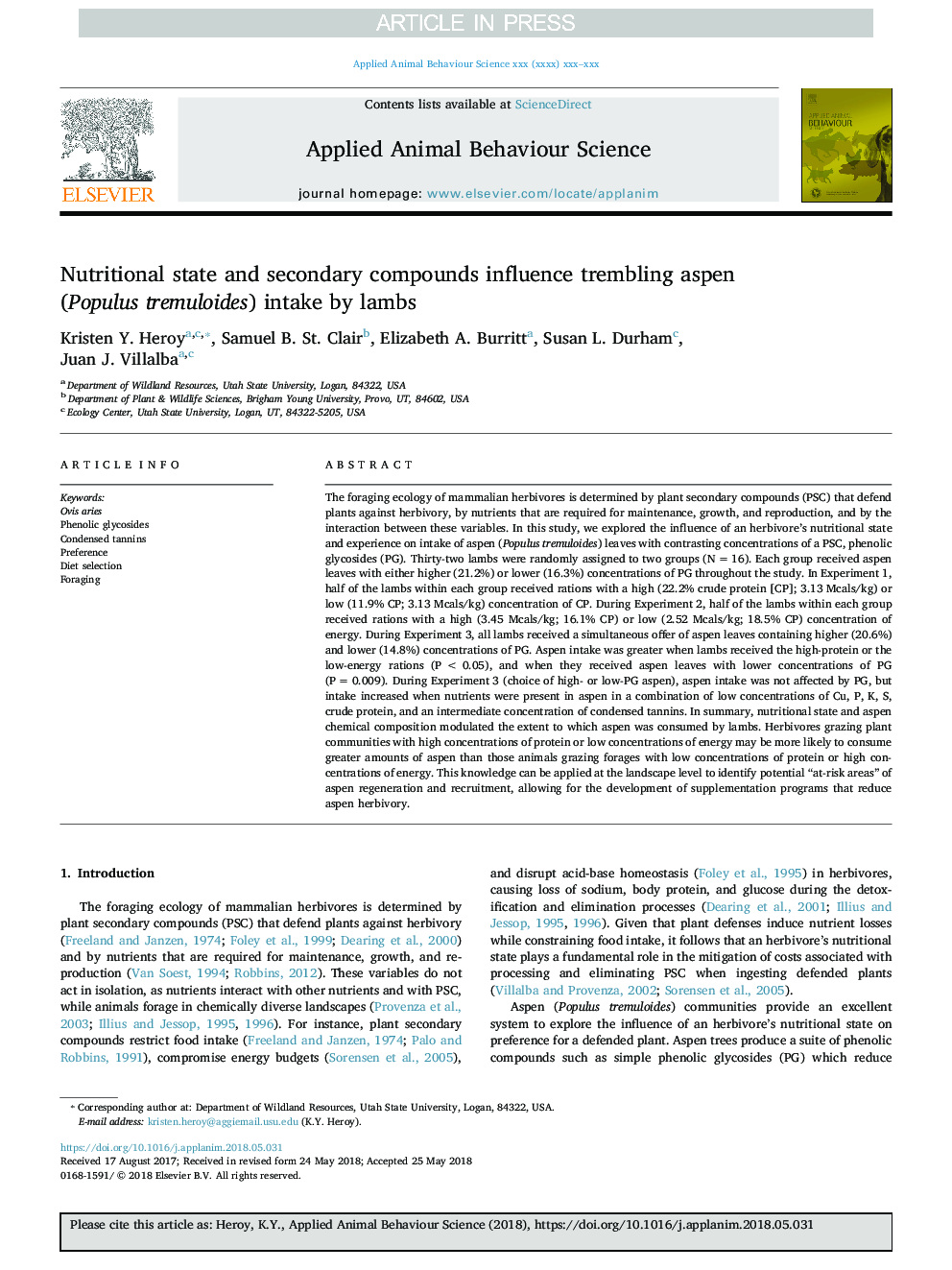| کد مقاله | کد نشریه | سال انتشار | مقاله انگلیسی | نسخه تمام متن |
|---|---|---|---|---|
| 8882688 | 1625300 | 2018 | 13 صفحه PDF | دانلود رایگان |
عنوان انگلیسی مقاله ISI
Nutritional state and secondary compounds influence trembling aspen (Populus tremuloides) intake by lambs
دانلود مقاله + سفارش ترجمه
دانلود مقاله ISI انگلیسی
رایگان برای ایرانیان
کلمات کلیدی
موضوعات مرتبط
علوم زیستی و بیوفناوری
علوم کشاورزی و بیولوژیک
علوم دامی و جانورشناسی
پیش نمایش صفحه اول مقاله

چکیده انگلیسی
The foraging ecology of mammalian herbivores is determined by plant secondary compounds (PSC) that defend plants against herbivory, by nutrients that are required for maintenance, growth, and reproduction, and by the interaction between these variables. In this study, we explored the influence of an herbivore's nutritional state and experience on intake of aspen (Populus tremuloides) leaves with contrasting concentrations of a PSC, phenolic glycosides (PG). Thirty-two lambs were randomly assigned to two groups (Nâ¯=â¯16). Each group received aspen leaves with either higher (21.2%) or lower (16.3%) concentrations of PG throughout the study. In Experiment 1, half of the lambs within each group received rations with a high (22.2% crude protein [CP]; 3.13 Mcals/kg) or low (11.9% CP; 3.13 Mcals/kg) concentration of CP. During Experiment 2, half of the lambs within each group received rations with a high (3.45 Mcals/kg; 16.1% CP) or low (2.52 Mcals/kg; 18.5% CP) concentration of energy. During Experiment 3, all lambs received a simultaneous offer of aspen leaves containing higher (20.6%) and lower (14.8%) concentrations of PG. Aspen intake was greater when lambs received the high-protein or the low-energy rations (Pâ¯<â¯0.05), and when they received aspen leaves with lower concentrations of PG (Pâ¯=â¯0.009). During Experiment 3 (choice of high- or low-PG aspen), aspen intake was not affected by PG, but intake increased when nutrients were present in aspen in a combination of low concentrations of Cu, P, K, S, crude protein, and an intermediate concentration of condensed tannins. In summary, nutritional state and aspen chemical composition modulated the extent to which aspen was consumed by lambs. Herbivores grazing plant communities with high concentrations of protein or low concentrations of energy may be more likely to consume greater amounts of aspen than those animals grazing forages with low concentrations of protein or high concentrations of energy. This knowledge can be applied at the landscape level to identify potential “at-risk areas” of aspen regeneration and recruitment, allowing for the development of supplementation programs that reduce aspen herbivory.
ناشر
Database: Elsevier - ScienceDirect (ساینس دایرکت)
Journal: Applied Animal Behaviour Science - Volume 206, September 2018, Pages 39-51
Journal: Applied Animal Behaviour Science - Volume 206, September 2018, Pages 39-51
نویسندگان
Kristen Y. Heroy, Samuel B. St. Clair, Elizabeth A. Burritt, Susan L. Durham, Juan J. Villalba,